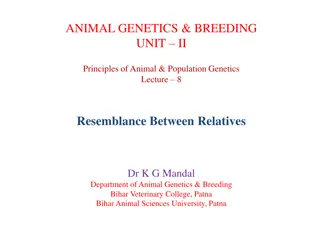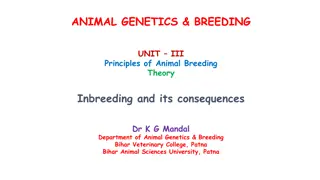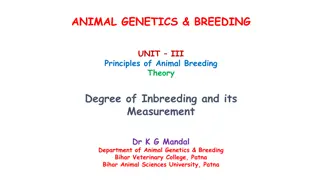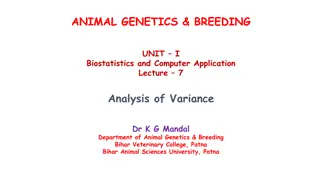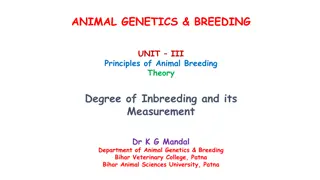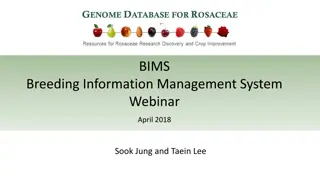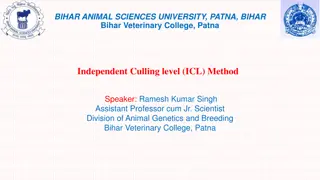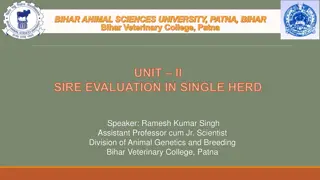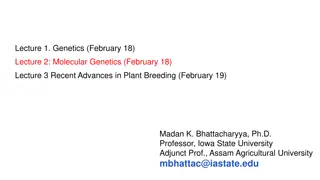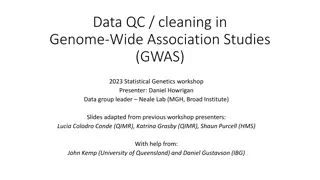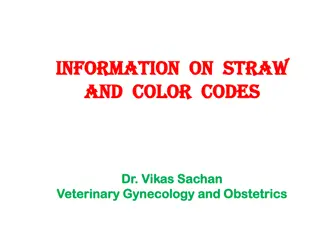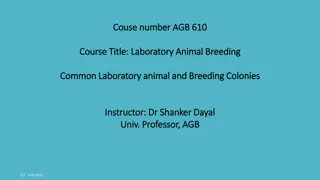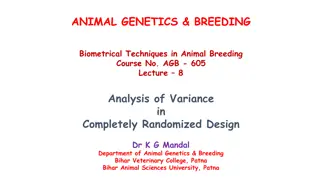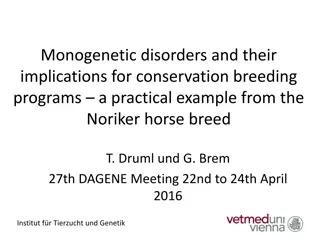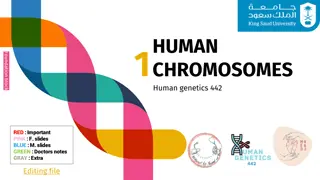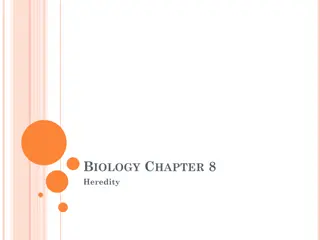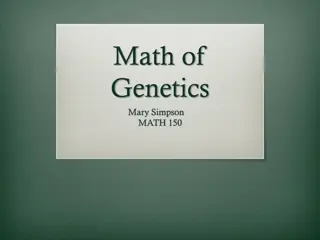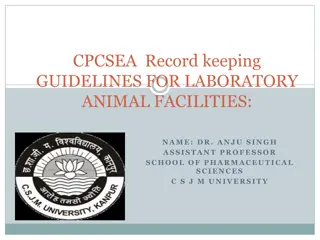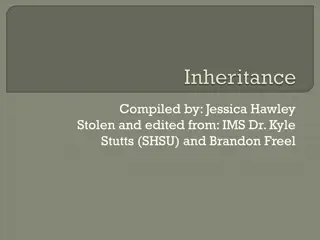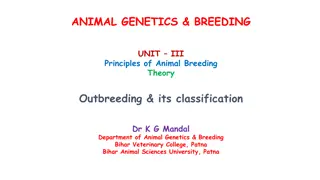Understanding Heritability in Animal Genetics and Breeding
Heritability is a crucial concept in animal genetics and breeding, indicating the proportion of total phenotypic variance attributed to genetic effects. It helps in predicting breeding values, assessing relationships between individuals, and guiding genetic determinations. Properties of heritability range from 0 to 1, with low, medium, and high categories based on the percentage. This metric parameter plays a vital role in animal breeding programs.
Download Presentation

Please find below an Image/Link to download the presentation.
The content on the website is provided AS IS for your information and personal use only. It may not be sold, licensed, or shared on other websites without obtaining consent from the author. Download presentation by click this link. If you encounter any issues during the download, it is possible that the publisher has removed the file from their server.
E N D
Presentation Transcript
ANIMAL GENETICS & BREEDING UNIT II Principles of Animal & Population Genetics Lecture 8 Heritability (Principles) Dr K G Mandal Department of Animal Genetics & Breeding Bihar Veterinary College, Patna Bihar Animal Sciences University, Patna
Introduction to Heritability The term heritability was introduced in Animal Breeding for the first time by Prof. J. L. Lush. Heritability characteristic character. Why ? is the most of important a metric feature It express the proportion of total phenotypic variance which is attributable to the average effect of genes.
It resemblance between relatives. It helps in prediction of breeding value from phenotypic value. It express the reliability of phenotypic value as a guide to the breeding value. It measures the degree of correlation between breeding value and phenotypic value. determines the degree of
Definition: 1. In broad sense, it is the ratio of genetic variance to the phenotypic variance. h2 = VG/VP 2. In narrow sense, it is the ratio of additive genetic phenotypic variance. h2 = VA/VP 3. It is the regression of breeding value on phenotypic value. bop = VA/VP , 2 bop = VA/VP = h2 bop = VA/ VP = VA/VP = h2 variance to the
4. It measures the strength of relationship between breeding value and phenotypic value. Heritability can be defined as the square of correlation between breeding value and phenotypic value. since, h = rAP, then, h2 = r2AP Where, r stands for correlation, A = Breeding Value P = Phenotypic value
Properties of heritability: It ranges from 0 to 1 or 0 to 100% Since, it is the ratio of variance components it cannot be negative. h2 stands for heritability not square of h. The symbol derives from Prof. S. Wright s (1921) terminology, h stands for ratio of A / V. Low h2 : 0 20% Medium h2 : 20 40% High h2 : 40 100%
Use of heritability It is the most important and useful genetic parameter of metric character. 1. It express the proportion of total variance which is attributable to the average effect of genes. h2=VA/VP 2. Can be used for genetic determination of an individual. h2B=VG/VP
3. It determines the degree of resemblance between relatives Relatives Degree of resemblance Cov OP / 2P Regression (b) Or correlation (r) bop = VA/VP Heritability (h2) bop = h2 or, h2 = 2bop bop = h2 Offspring & one parent bop = VA/ VP = VA/VP t = VA/VP CovOP/ 2P Offspring & mid-parent t = h2 Or, h2 t = h2 + VD/ VP Or, h2 = 2t - VD/VP Cov(HS)/ 2P Half sibs = 4t Cov(FS)/VP t =( VA + VD)/VP Full sibs
4.The most important function of h2 is the prediction of breeding value on the basis of phenotypic value. 5. It express the reliability of phenotypic value as a guide to the breeding value(bAP). 6. It measures the correlation between breeding value and phenotypic value (rAP).
7. It is used for prediction of genetic gain/response to selection. R=h2S 8. It provides the estimation of accuracy of selection. h2 = h = rAP = accuracy of selection. 9. It plays vital role in the formulation of breeding plan for genetic improvement of livestock and poultry.
Misconceptions about h2 1. It is wrongly interpreted that if a trait has high heritability, then the breeding value for the trait will also be high. High heritability means a strong relationship between breeding value and phenotypic value. Strong relationship is indicated by rAP (h2 = r2AP ). It does not indicate about high or low magnitude of h2.
2. It is wrongly interpreted that selection and inbreeding homozygosity in the population so increases the magnitude of heritability also. Virtually due to long term selection or inbreeding fixes the genes and thereby reduces genetic variability (VA ). However, the traits having high VA shows higher h2 than the traits affected largely by non-additive gene action. increases the
3. Heritability is a property not only of a character but also of the population and environmental circumstances to which the individuals are kept. (i) Heritability is a property of a character. h2 = VA/VP VA = 2pq 2 = 2pq[a + d(q p)]2 VP = VA + VD + VI + VE
VA is the function of gene frequencies. Hence, any change in gene frequency leads to change in the amount of VA and the magnitude of h2. (ii) h2 is a property of the population: The genetic population and its size affect the h2 . Genetically more uniform population show low h2 than the genetically distant population. structure of the
Since, all the genetic components of variance are influenced by the gene frequencies and therefore, differ from population to population. Small population maintained for a long period of time is expected to have low h2 due to inbreeding. Magnitude of h2 of a character may vary from time to time even within the same population.
(iii) h2 is a property of environmental conditions: h2 = VA/VP = VA/(VA + VD + VI + VE ) h2 depends on management conditions. The more variable conditions increases the magnitude of VE thereby reduces h2 and vice versa. - h2 estimates are more accurate for herds kept under uniform feeding and management conditions. management
h2 is also reduced due to differences in the age of the animals. The variation in the age of animals increases residual or error variance which leads to increase VP, thereby reduces the magnitude of h2 . Therefore, h2 is not only the property of a character but also the property of the population and conditions. environmental
Thus, whenever the value of h2of a character is mentioned, it must be referred the particular population as well as environmental conditions in which the animals were kept.
Table 1.Approximate values of h2 of various characters in various species of animals Species Characters h2 (%) Man Height 65 Cattle Adult body weight 65 Butter fat % 40 Lactation Milk Yield 35 Pigs Back fat thickness 70 Feed conversion ratio 50 Litter Size 5 Poultry Body weight (at 32 weeks) 55 Egg weight 50 Egg Production 10 Mice Litter size 20 Drosophila Abdominal bristle number 50 Egg Production 20






